
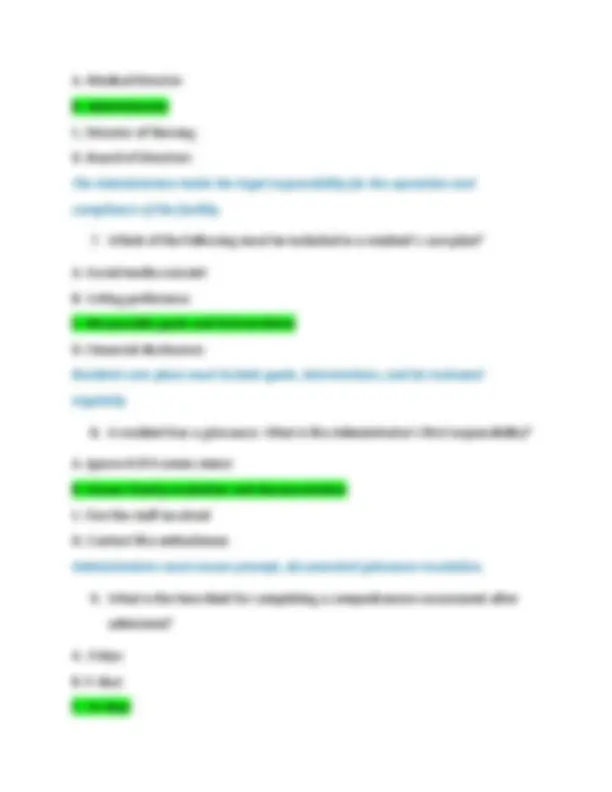
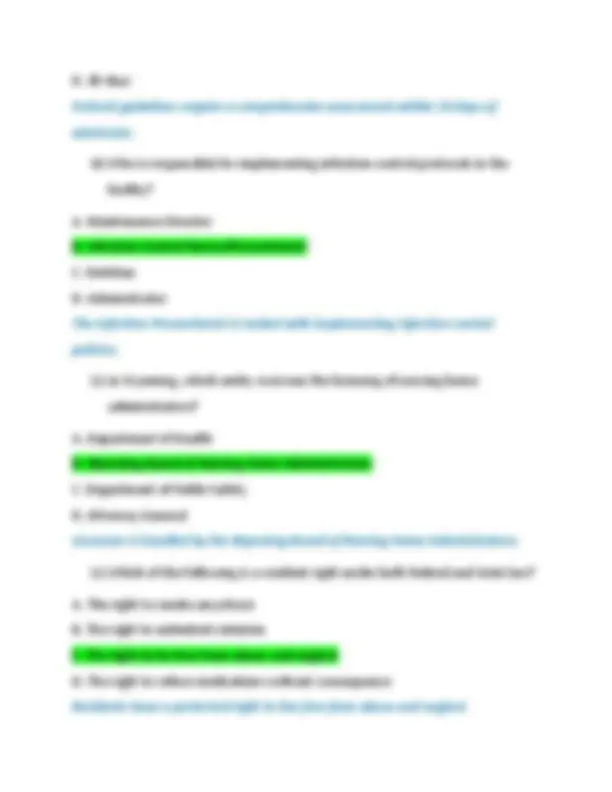
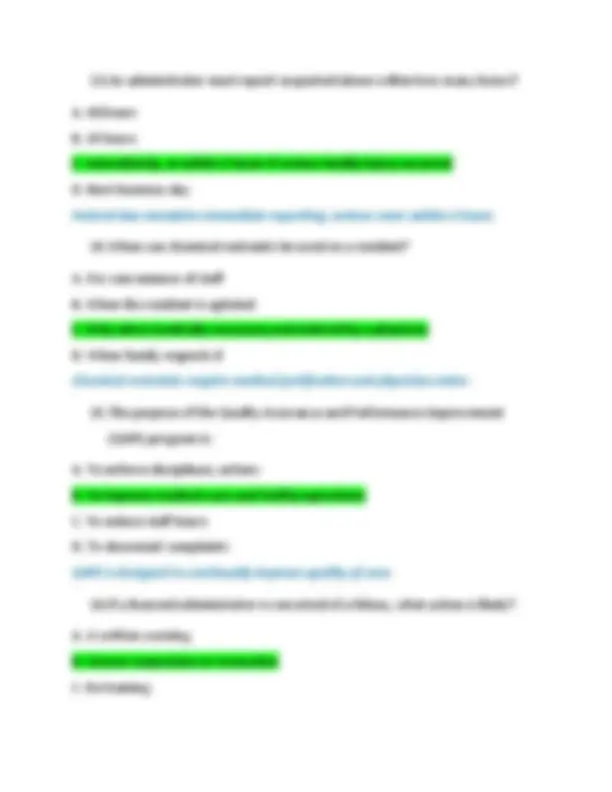
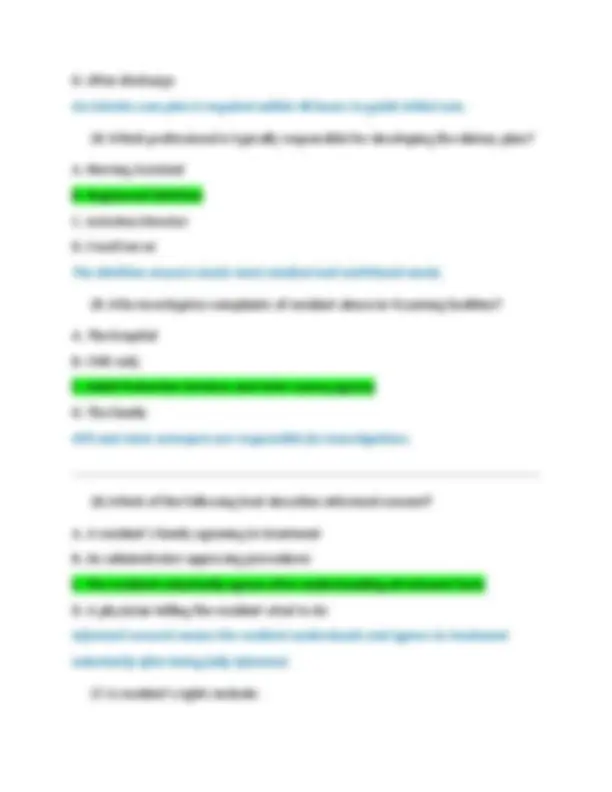
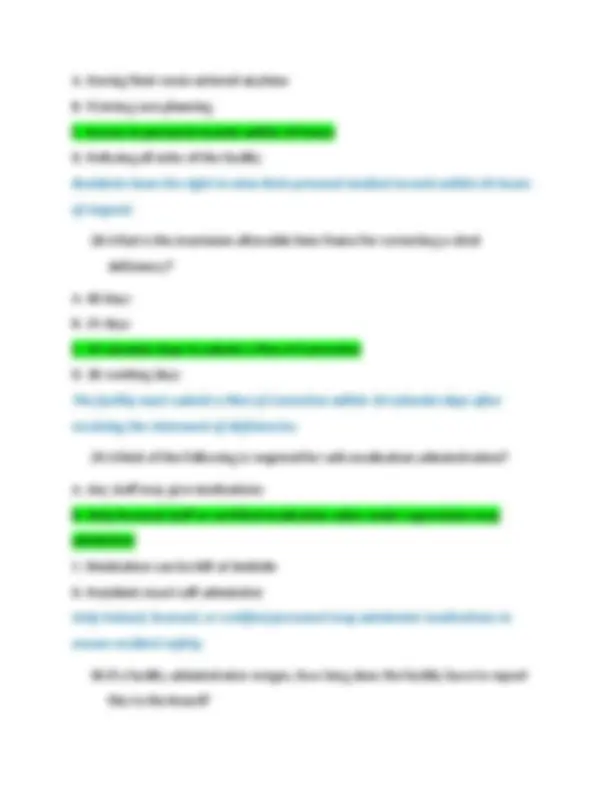
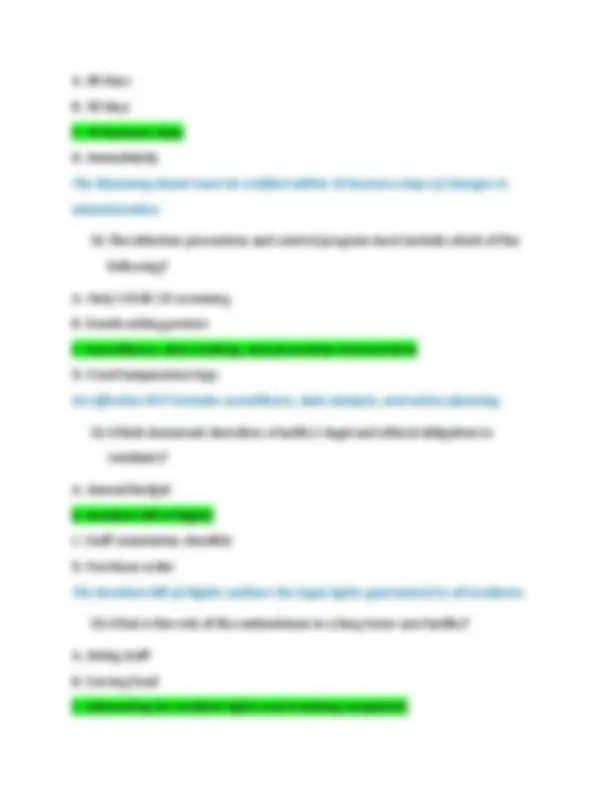
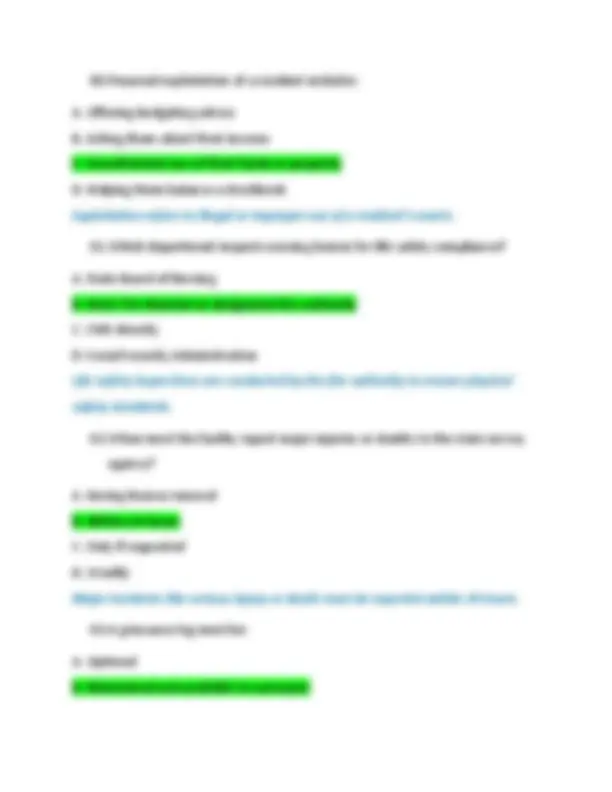
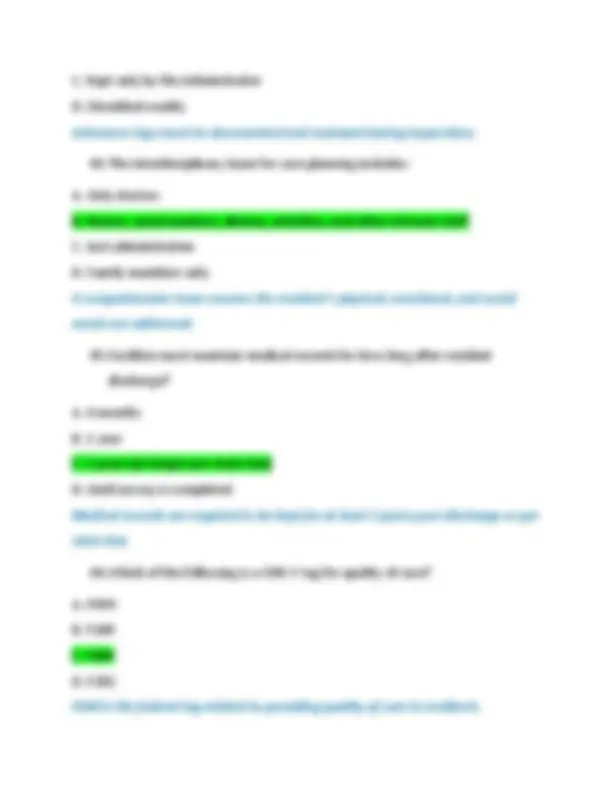
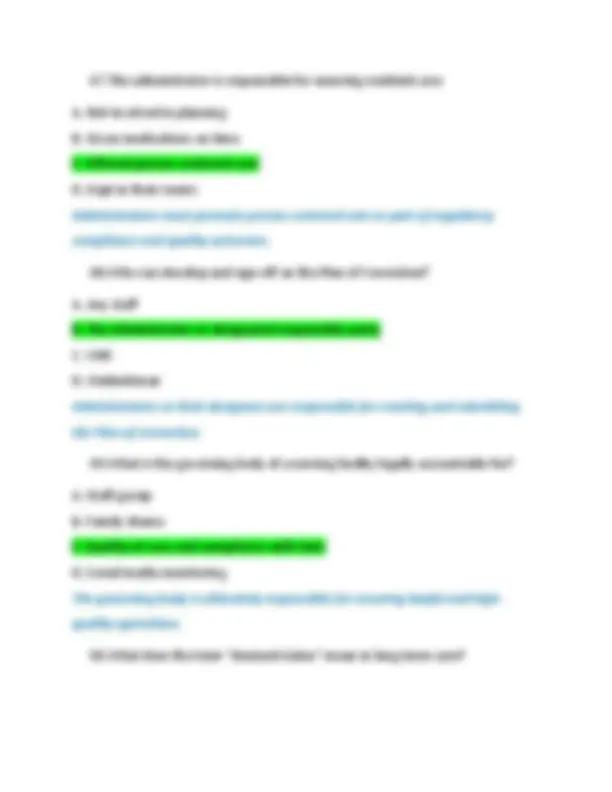


Study with the several resources on Docsity

Earn points by helping other students or get them with a premium plan


Prepare for your exams
Study with the several resources on Docsity

Earn points to download
Earn points by helping other students or get them with a premium plan
Community
Ask the community for help and clear up your study doubts
Discover the best universities in your country according to Docsity users
Free resources
Download our free guides on studying techniques, anxiety management strategies, and thesis advice from Docsity tutors
Wyoming State Board of Nursing Home Administrators Questions And Correct Answers (Verified Answers) Plus Rationales 2025 Q&A | Instant Download The questions are based on federal and Wyoming-specific guidelines as applicable for 2025/2026
Typology: Exams
1 / 16

This page cannot be seen from the preview
Don't miss anything!










D. 30 days Federal guidelines require a comprehensive assessment within 14 days of admission. 10.Who is responsible for implementing infection control protocols in the facility? A. Maintenance Director B. Infection Control Nurse/Preventionist C. Dietitian D. Administrator The Infection Preventionist is tasked with implementing infection control policies. 11.In Wyoming, which entity oversees the licensing of nursing home administrators? A. Department of Health B. Wyoming Board of Nursing Home Administrators C. Department of Public Safety D. Attorney General Licensure is handled by the Wyoming Board of Nursing Home Administrators. 12.Which of the following is a resident right under both federal and state law? A. The right to smoke anywhere B. The right to unlimited visitation C. The right to be free from abuse and neglect D. The right to refuse medications without consequence Residents have a protected right to live free from abuse and neglect.
13.An administrator must report suspected abuse within how many hours? A. 48 hours B. 24 hours C. Immediately, or within 2 hours if serious bodily injury occurred D. Next business day Federal law mandates immediate reporting; serious cases within 2 hours. 14.When can chemical restraints be used on a resident? A. For convenience of staff B. When the resident is agitated C. Only when medically necessary and ordered by a physician D. When family requests it Chemical restraints require medical justification and physician order. 15.The purpose of the Quality Assurance and Performance Improvement (QAPI) program is: A. To enforce disciplinary actions B. To improve resident care and facility operations C. To reduce staff hours D. To document complaints QAPI is designed to continually improve quality of care. 16.If a licensed administrator is convicted of a felony, what action is likely? A. A written warning B. License suspension or revocation C. Re-training
A. Payroll B. Establishing and ensuring adherence to facility policies C. Night shift staffing D. Ombudsman visits The governing body sets overall policy and ensures the Administrator implements them. 21.What is the purpose of the state survey process? A. To promote facility marketing B. To recruit new staff C. To ensure compliance with state and federal regulations D. To offer facility bonuses Surveys ensure facilities meet quality and regulatory standards. 22.How often must fire drills be conducted in nursing homes? A. Annually B. Quarterly on each shift C. Weekly D. Biannually Fire drills must be conducted quarterly on each shift per Life Safety Code requirements. 23.When is an interim care plan required? A. Within 5 days of admission B. Within 48 hours of admission C. Within 30 days of admission
D. After discharge An interim care plan is required within 48 hours to guide initial care. 24.Which professional is typically responsible for developing the dietary plan? A. Nursing Assistant B. Registered Dietitian C. Activities Director D. Food Server The dietitian ensures meals meet medical and nutritional needs. 25.Who investigates complaints of resident abuse in Wyoming facilities? A. The hospital B. CMS only C. Adult Protective Services and state survey agency D. The family APS and state surveyors are responsible for investigations. 26.Which of the following best describes informed consent? A. A resident’s family agreeing to treatment B. An administrator approving procedures C. The resident voluntarily agrees after understanding all relevant facts D. A physician telling the resident what to do Informed consent means the resident understands and agrees to treatment voluntarily after being fully informed. 27.A resident’s rights include:
A. 60 days B. 30 days C. 10 business days D. Immediately The Wyoming Board must be notified within 10 business days of changes in administration. 31.The infection prevention and control program must include which of the following? A. Only COVID-19 screening B. Handwashing posters C. Surveillance, data tracking, and prevention interventions D. Food temperature logs An effective IPCP includes surveillance, data analysis, and action planning. 32.Which document describes a facility's legal and ethical obligation to residents? A. Annual budget B. Resident Bill of Rights C. Staff orientation checklist D. Purchase order The Resident Bill of Rights outlines the legal rights guaranteed to all residents. 33.What is the role of the ombudsman in a long-term care facility? A. Hiring staff B. Serving food C. Advocating for resident rights and resolving complaints
D. Running financial audits Ombudsmen act as independent advocates for resident rights and concerns. 34.What is considered a sentinel event in long-term care? A. Losing a set of linens B. An unexpected death or serious injury C. A missed activity D. Scheduling conflict Sentinel events are unexpected occurrences like death or serious physical or psychological injury. 35.The primary goal of care planning is: A. Staff discipline B. Medication cost reduction C. Meeting the individual needs and goals of the resident D. Billing accuracy Care planning focuses on personalized care that supports the resident’s health and preferences. 36.Facilities must provide residents with a notice of discharge or transfer at least how many days in advance? A. 5 days B. 10 days C. 30 days D. 60 days Residents must receive a 30-day written notice before involuntary discharge or transfer unless it's an emergency.
40.Financial exploitation of a resident includes: A. Offering budgeting advice B. Asking them about their income C. Unauthorized use of their funds or property D. Helping them balance a checkbook Exploitation refers to illegal or improper use of a resident’s assets. 41.Which department inspects nursing homes for life safety compliance? A. State Board of Nursing B. State Fire Marshal or designated fire authority C. CMS directly D. Social Security Administration Life safety inspections are conducted by the fire authority to ensure physical safety standards. 42.When must the facility report major injuries or deaths to the state survey agency? A. During license renewal B. Within 24 hours C. Only if requested D. Weekly Major incidents like serious injury or death must be reported within 24 hours. 43.A grievance log must be: A. Optional B. Maintained and available to surveyors
C. Kept only by the Administrator D. Shredded weekly Grievance logs must be documented and reviewed during inspections. 44.The interdisciplinary team for care planning includes: A. Only doctors B. Nurses, social workers, dietary, activities, and other relevant staff C. Just administration D. Family members only A comprehensive team ensures the resident’s physical, emotional, and social needs are addressed. 45.Facilities must maintain medical records for how long after resident discharge? A. 6 months B. 1 year C. 5 years (or longer per state law) D. Until survey is completed Medical records are required to be kept for at least 5 years post-discharge or per state law. 46.Which of the following is a CMS F-tag for quality of care? A. F B. F C. F D. F F684 is the federal tag related to providing quality of care to residents.
A. Loss of certification B. Fully state-regulated C. Facility accredited by an agency recognized by CMS and thus exempt from routine surveys D. State-run operations only Deemed status allows CMS-recognized accredited facilities to bypass some standard inspections.